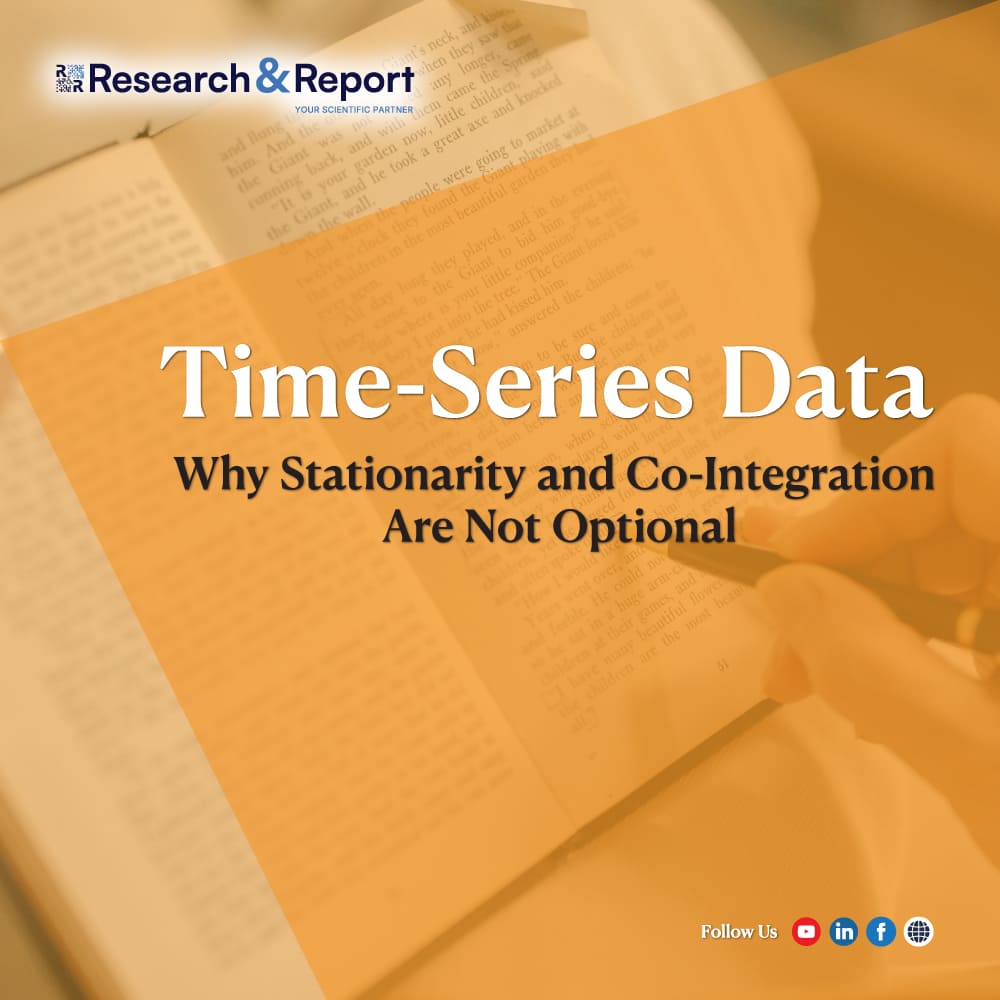Time-series models are among the most powerful tools in empirical research — used to forecast trends, evaluate policy impacts, and assess long-term relationships across economics, finance, climate, and public policy. But too often, researchers focus on sophisticated modeling techniques (like ARDL, VAR, or VECM) without laying the proper statistical foundation.
The result? Spurious regressions, invalid inferences, and rejected manuscripts.
At Research & Report, we frequently encounter time-series analyses that fail not due to model complexity, but due to basic neglect of stationarity and co-integration — the two pillars of reliable time-series modeling.
What is Stationarity — and Why Does It Matter?
Stationarity refers to the statistical property of a time-series where the mean, variance, and autocovariance remain constant over time. In simple terms, a stationary series doesn’t “drift” or trend unpredictably.
If your variable is non-stationary, standard regression results (like OLS) become unreliable because:
- The standard errors are biased.
- The significance tests (t-tests, F-tests) become invalid.
- The model can show strong relationships even when none exist — the classic spurious regression.
A model with high R² and significant p-values can still be completely meaningless if based on non-stationary data.
Common Signs Your Data Is Non-Stationary
- Trending upward or downward over time
- High autocorrelation even at long lags
- Non-constant variance (heteroskedasticity over time)
Why Co-Integration Cannot Be Ignored?
When multiple time-series variables are non-stationary but move together in the long run, they may be co-integrated.
Co-integration implies the existence of a stable, long-run equilibrium relationship, even if short-run dynamics fluctuate.
Neglecting to test for co-integration before estimating relationships (especially in models like ARDL or ECM) leads to:
- Misinterpretation of long-run coefficients
- Incorrect model specification
- Policy conclusions that don’t hold over time
In short: if your variables are I(1), you must test for co-integration before estimating any long-run model.
Critical Mistakes Researchers Often Make in Time-Series Modeling
- Running regressions without testing for stationarity
Many skip unit root tests (ADF, PP, KPSS), assuming their data is stable. - Misusing ARDL when all variables are I(1)
ARDL requires that not all variables be integrated of order 1 (I(1)) — it assumes a mix of I(0) and I(1). Using it blindly is a major error. - Differencing all variables to achieve stationarity
While differencing can induce stationarity, it also removes long-run information — defeating the purpose of long-run modeling. - Confusing correlation with co-integration
High correlation between trending variables doesn’t imply a meaningful long-run relationship. Only co-integration tests (e.g., Johansen, Bounds test) can validate it. - Not justifying effect dynamics
Researchers often fail to discuss why variables are expected to be co-integrated or why stationarity matters for their context — weakening the theoretical narrative.
Best Practices for Time-Series Modeling
To ensure the integrity and publishability of your time-series study:
- Always conduct unit root tests (ADF, PP, KPSS) before modeling.
- Check order of integration (I(0), I(1)) before choosing your model (e.g., ARDL, VECM, VAR).
- Test for co-integration when dealing with multiple I(1) variables (Johansen, Bounds test).
- Do not difference all variables blindly — it may mask meaningful long-run equilibrium.
Align your empirical strategy with theory — not just statistical fit.
Final Thought
Time-series analysis is not just about fitting models — it’s about respecting the temporal structure of data. Ignoring stationarity and co-integration is like skipping the foundation and going straight to painting the house. It might look finished, but it won’t stand.
Rigor starts with diagnostics.
If you can’t justify the time properties of your variables, you can’t justify the results.
Need support with time-series modeling, unit root testing, or co-integration diagnostics?
Let Research & Report help you build valid, credible, and publication-ready time-series research.
Want to explore more insights! visit Research & Report blogs

